Boost your skills with Growth Memo’s weekly expert insights. Subscribe for free!
Taking a break from analyzing leaked Google ranking factors and AI Overviews, let’s come back to the question, “Do big sites get an unfair advantage in Google Search?”
In part 1 of David vs. Goliath, I found that bigger sites indeed grow faster than smaller sites, but likely not because they’re big but because they’ve found growth levers they can pull over a long time period.
- The analysis of 1,000 winner and 1,000 loser sites shows that communities have gained disproportional SEO visibility over the last 12 months, while ecommerce retailers and publishers have lost the most.
- Backlinks seem to have lost weight in Google’s ranking systems over the last 12 months, even though overperformers still have stronger backlink profiles than underperformers.
- However, newcomer sites still have good chances to grow big, but not in established verticals.
The correlation between SEO visibility and the number of linking domains is strong but was higher in May 2023 (.81) than in May 2024 (0.62). Sites that lost organic traffic showed lower correlations (0.39 in May 2023 and 0.41 in May 2024). Even though sites that gained organic visibility have more backlinks, the signal seems to have come down significantly over the last 12 months.
In the second part, I share more insights from the data about how and when sites grow or decline in SEO traffic. My goal is to colorize the modern, working approach to SEO and contrast the old, dying approach.
Insights:
- Most sites lose during core algorithm updates but win outside of them.
- Most sites grow linearly, not “exponentially.”
- Tool + programmatic SEO works well.
- High ad load and confusing design work poorly.
Image Credit: Lyna ™
Hard(Core) Algorithm Updates
During almost half of the year, you can expect at least one Google update to be rolling out.
According to the official page for ranking “incidents,” 2021-2023 had an average of 170 days of Google updates.

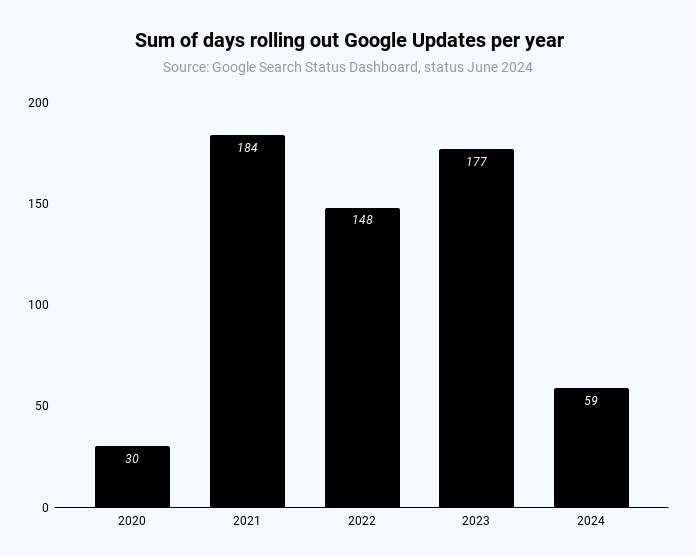 Days of the year with Google updates (Image Credit: Kevin Indig)
Days of the year with Google updates (Image Credit: Kevin Indig)
Keep in mind that roll-out days reflect official updates and the times new updates roll out. The impact of updated rank systems can come into effect way after roll-out when new data is infused into the system, according to Danny Sullivan.
So the folks going “it’s a never ending update” or “the update isn’t over,” search is always being updated.
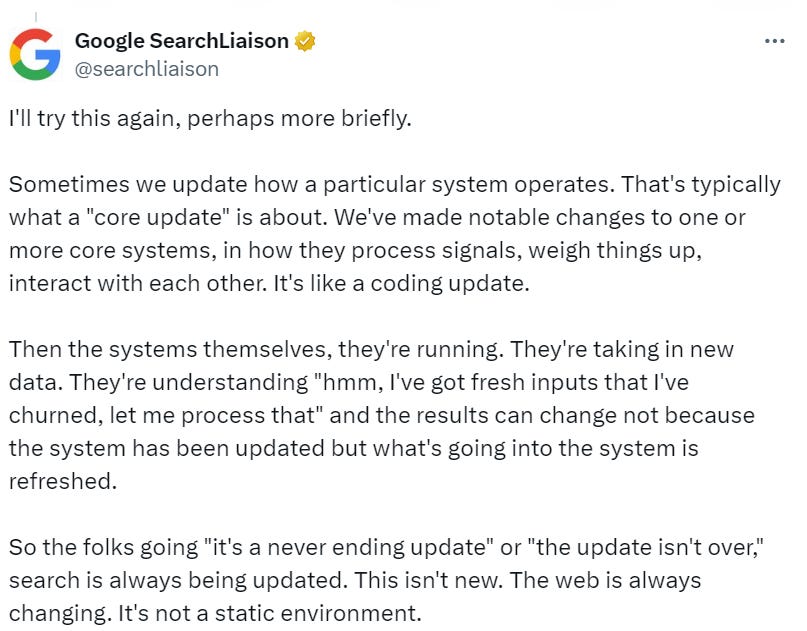 Image Credit: Kevin Indig
Image Credit: Kevin Indig
As I wrote in Hard(Core) Algorithm Updates, algo updates become a growing challenge for Google as a user acquisition channel:
No platform has as many changes of requirements. Over the last 3 years, Google launched 8 Core, 19 major and 75-150 minor updates. The company mentions thousands of improvements every year.
Every platform improves its algorithms, but not as often as Google. Instagram launched 6 major algorithm changes over the last 3 years. Linkedin launched 4.
The top 1,000 domains with the biggest traffic losses reflect the risk: When a domain loses organic traffic, it’s most likely due to a Google core algorithm update. A few examples:
- In SaaS, applicant tracking software company Betterteam was caught by the September 2023 Helpful Content and October 2023 core update, likely because of too much programmatic “low-quality” content.
- Hints from the Google ranking factor leak indicate a connection between brand searches, backlinks, and content. Whether that’s true or not and if we can influence it remains to be seen, but for Betterteam, brand searches have stagnated since March 2022 while the number of pages has been growing.
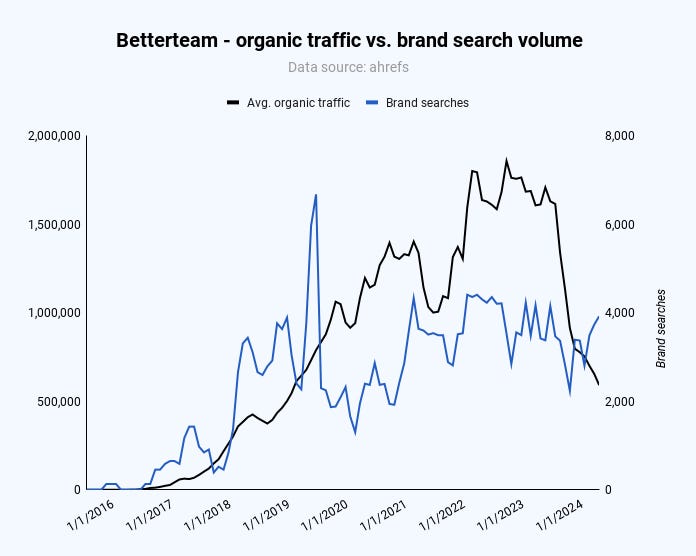 Image Credit: Kevin Indig
Image Credit: Kevin Indig
- In ecommerce, big US retailers across all verticals (fashion, home, mega-retailers) have been on the decline since the August 2023 core update. More about that in a moment.
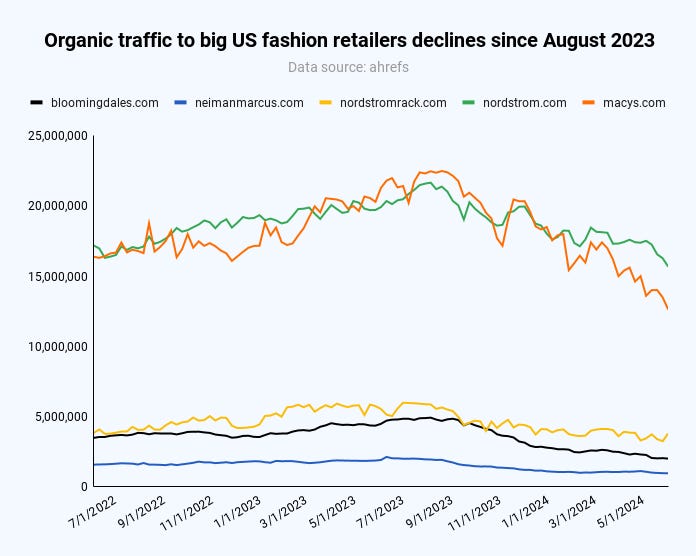 Image Credit: Kevin Indig
Image Credit: Kevin Indig
- In publishing, sites like Movieweb have also started declining since August 2023. In this case, it’s interesting how Screenrant picks up market share but also dips during the March 2024 core update.
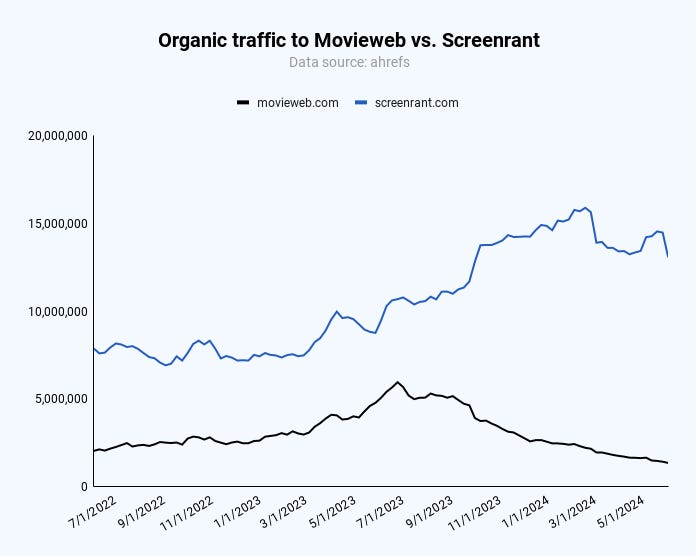 Image Credit: Kevin Indig
Image Credit: Kevin Indig
Overlapping algorithm updates make it near-impossible to understand what happened, which is a reverse engineering problem for SEO pros and also a guideline issue for anyone responsible for organic traffic. To understand what guideline you violated, you need to be able to understand what happened.
S-Curves Are Rare
It’s rare for a domain to grow exponentially (
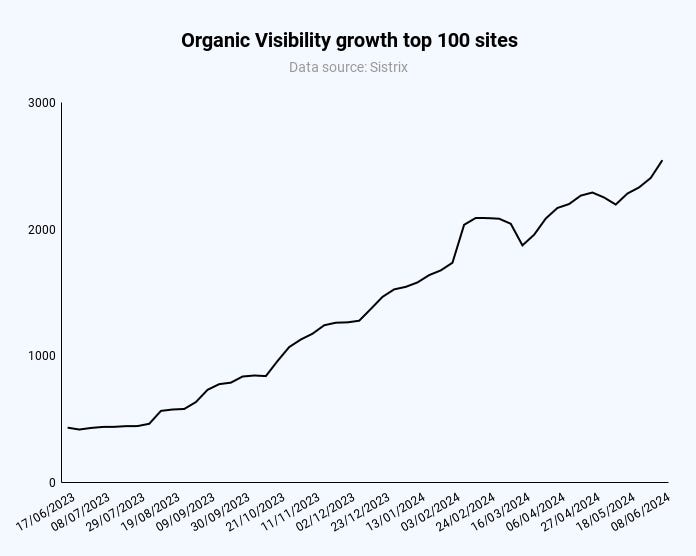 Image Credit: Kevin Indig
Image Credit: Kevin Indig
A great example of the modern approach to SEO in SaaS is the AI tool Quillbot. With a simple but effective design, the tool makes it easy for users to solve issues instead of reading about how to solve them.
Owner Learneo, who also owns Course Hero, saw consistent growth outside of Google algorithm updates. Like German startup DeepL, Quillbot has programmatic pages for translation queries like “translate Arabic to Hindu” or “translate German to English.” The combination of programmatic SEO and a tool works like a charm.
Public relations management tool Muck Rack has programmatic pages for every client (+50,000) in its /media-outlet/ folder, like muckrack.com/media-outlet/fintechzoom. Each page ranks for the client name and has a description, a few details about the company, and the latest press releases for fresh content. Despite not being a tool, the programmatic play works, and Google deems it valuable.
In ecommerce, brands saw the strongest growth.
A few examples:
- Kay Jewelry (outlet).
- Lenovo.
- Steve Madden.
- Sigma (photo).
- Billabong.
- Coleman.
- Hanes.
- Etc.
Obviously, there are exceptions on both fronts: brands that lost organic traffic and retailers that gained. We need more data, but it seems that Google has favored brands in the search results over retailers since August 2023.
In publishing, garagegymreviews.com is one of the few affiliate sites that has seen strong growth. It’s important to point out that the main channel of the business is YouTube.
Another example is fodors.com, a travel site that grew predominantly because of its community.
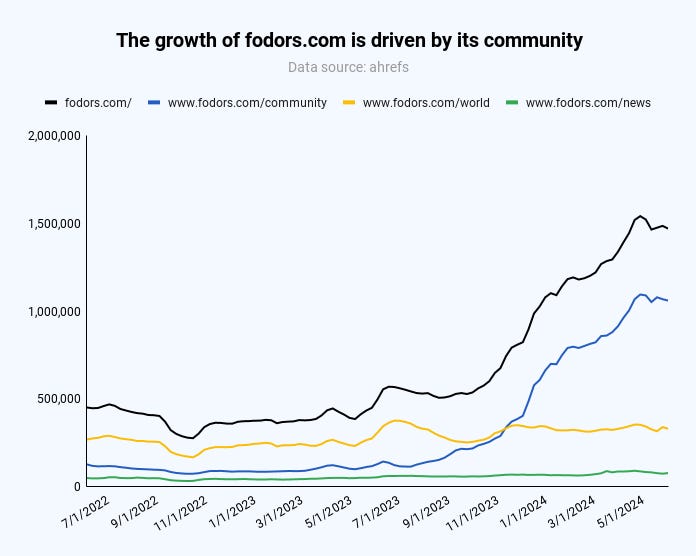 Image Credit: Kevin Indig
Image Credit: Kevin Indig
Algo Thrashing
We want a better Google, and Google seems to have taken notice. The response is stronger algorithms that can thrash sites into oblivion and have become the biggest risk in SEO.
At the same time, I haven’t noticed many sites growing due to algorithm updates, meaning the positive effect is indirect: Competitors might be losing traffic.
The big question to finish with is how to mitigate the risk of being hit by an algorithm update. While there is absolutely no guarantee, we can agree on what sites that are unaffected by updates have in common:
- Allowing Google to index only high-quality pages.
- Investing in content quality with expert writers and high effort (research, design).
- Offering good design that makes content easy to read and answers quick to find.
- Reducing ads as much as possible.
Google Search Status Dashboard




